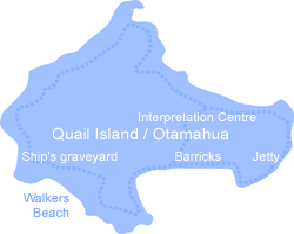



A lonely grave on Quail Island in Lyttelton harbour is a sad reminder of New Zealand's involvement with Leprosy.
Ivon Crispen Skelton (1898-1925) lies buried there, within a neat picket fence, a victim of the biblical disease and society's fears. Avon Skelton was borm in Apia, Samoa, and brought his unsuspected leprosy with him to New Zealand, when he visited relatives on the West Coast. He was not the first, nor the last, to do so. George Phillips, a soldier in the New Zealand Expeditionary Force to Samoa, in 1914, developed the disease in 1916. This event caused a great sensation, in 1925, then he declared himself "cured" and escaped from Quail Island.
When a case of leprosy was discovered in Christchurch in 1906, the Health Minister took rapid action and banished old Will Vallane to the Quarantine station on Quail Island. There a little cottage that was built for the nearly blind unfortunate. It was 200 yards beyond the quarantine line and fenced off from it. There he remained until the leper station closed in 1925.
A second leper, Jimmy Kokere, was sent to the island in 1908. He was discharged cured in 1909, but returned to nurse the nearly blind and helpless Will Vallane. Kokere left in 1917, but he died soon after.
A third patient came in 1909, and by 1924, there were nine lepers, including two Maori and two Chinese, each with his own cottage. The caretakers of the island, Mr. Thomas and his wife, provided cooked food, which was left at the fence.
Originally the Lyttelton doctor visited only once a month, but later this increased to twice a week. Dr. Charles Hazlitt Upham (uncle of Captain C. H. Upham, who twice won the Victoria Cross), was a Lyttelton doctor for fifty (50) years. After his retiring (in 1898) from his position as a Naval Medical Officer aboard H.M.S. Torch, Upham was said to have been "a man of exceptional qualifications and exceptional devotion." He became a friend to his leper patients. His kindness, to the lepers, and his work for the poor, is still remembered in Lyttelton.
The island was conveniently situated, but was far from suitable, because it was very windy, and it lost the sun at 2 p.m., in the winter. The patients had complaints about promises made but not kept by the Health Department. Stock importers complained that they should not have to worry about when they were visiting their quarantined animals. These problems vanished in 1925, when all eight remaining lepers were transported to Fiji, to the leper station at Makogai Island.
In Lyttelton, the lot of the patients was greatly improved by the acts of a number of other Lyttelton people. Notable examples were Mr. S. Tredinnick, several Matrons and their assistants, and the Reverend A. J. Petrie (who organized visits by his parishioners for church services - he even brought over a piano), and some of the Maori community of Rapaki. The long confinement was relieved by gifts of books, a telephone, gramophone, radio, a billiard table, and a rowing boat. The more able made flower gardens, and all enjoyed pets - a magpie, a parrot, and many tame rabbits.
In 1993, the Pacific Leprosy Foundation approached the Department of Conservation (DOC) about the dilapidated grave site, and in 1997, a cousin of Ivon Skelton independently wrote to DOC. As a result, the grave was renovated and beautified, and a totara (native timber) cross was erected. The Vicar of Lyttelton rededicated the site, which now has a plaque explaining its significance.
The Pacific Leprosy Foundation, is still in existence - make no mistake. Leprosy still exists on many Pacific Islands, even though new medical treatments have lowered the percentages.
References:
Quail Island - a Link With the Past, DOC Publication, 1990.
Pacific Leprosy, Michael Gousmet, November 1977.
Newspaper clipping book, Lyttelton Maritime Museum.




